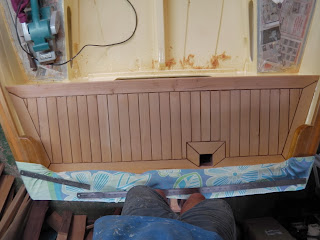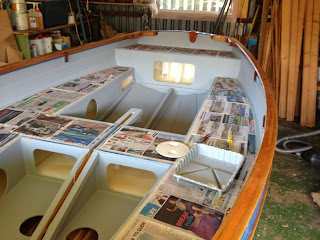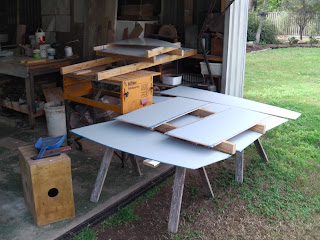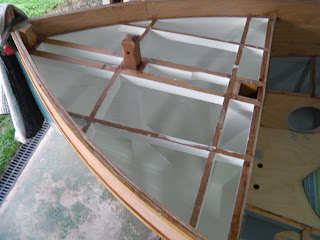Fitting these strips of timber along the gunwales has been more time consuming than I expected. I used three strips 20 x 12 mm along each gunwale. I fixed the middle strip along the centre of the gunwale first followed by the outside strip and lastly the inside strip. Each strip needed all the screw clamps that I have and a lot of tailor made plywood clamps with wedges to position the strip and/or hold it down. Even the 20 x 12mm section timber was difficult to bend to the curves involved and needed a lot of clamps to hold it in position.
The next photo shows the first strip being glued along the centre of the gunwale. The horizontal U plywood clamps hold the strip down to the gunwale; the vertical U clamps have a notch that aligns the strip along the centre of the gunwale. The photo was taken before all the clamps were in place.
With the first strip fixed in place the outer strip was less of a challenge, it only had to be held against the first strip and pulled down against the gunwale. Here it is shown at the start of the gluing held by a couple of G clamps at the bow of the boat. Clamps were added as required working towards the stern.
Here is a photo of the end of the gluing of the outer strip. This is at the transom and shows how many clamps were needed to hold the strip in place.
Here I have the second strip on the port side in place. The newspaper and masking tape are to keep the squeeze out epoxy off the paintwork on the outside of the boat. I couldn't resist the temptation to use William and Kate to catch some of the drips!
With the first two strips fitted on both sides of the boat the breasthook was shaped and glued in place. This next photo shows the breasthook in place with the second of the inside strips being glued.
The inside strip proved to be the hardest of the three to fit and glue. I expected it would be easier because it was being pulled in towards the first two strips but it didn't turn out to be like that. Because of the compound curve the strip wanted to twist and was very difficult to hold in a horizontal plane. More pairs of hands would have solved the problem but I was working by myself. The solution was to start from the stern and work forwards towards the bow. The curves at the stern are not as pronounced and so less twisting force was generated by the strip of timber. The problem was that this strip had to butt up against the end of the breast hook which I had now fixed in place. The solution to this was to trial fit the inner strip starting from the stern so that it ended up short of the breasthook. The shortfall was measured and the strip refitted, with glue, further forward by the amount of the shortfall.

Both sides finished so the strip over the top of the transom could be fitted. This strip had already being laminated from 3 strips each 20 x 12mm and was relatively to clamp in place. Once again I use newspaper and tape to protect the finished paintwork. Once again I couldn't resist, this time I have an Aussie Rules footballer on the back page of the paper and the whole Royal family on the front page, apologies to Charles who is hidden by my clamp!
Tomorrow's job is to fit the two quarter knees after which I can clean up the gunwales ready for varnishing.



















































